 Mini Review
Mini Review
Bibliometric Analysis of the Hot Theme “Phytosynthesized Nanoparticles”
Thuanny Moraes De Almeida1, Kaushik Pal2 and Fernando Gomes de Souza1*
Institute of Macromolecules: Professor Eloisa Mano, Technology Center, Federal University of Rio de Janeiro, Brazil.
2Department of Nanotechnology, Bharath Institute of Higher Education and Research, India
Fernando Gomes de Souza, Institute of Macromolecules: Professor Eloisa Mano, Technology Center, Federal University of Rio de Janeiro, Brazil
Received Date: March 06, 2020; Published Date: April 27, 2020
Abstract
Nanoparticle biosynthesis is an emerging area in Nanoscience, guided by an acute demand for new and more efficient methods for the synthesis of nanoparticles. One of the simplest alternatives is the use of plant extracts or even biological microorganisms. Among these alternatives, the use of plant extracts is fully capable of replacing classical chemical and physical methods. Nanoparticle biosynthesis based on the use of several plants and their most distinct components is simple, efficient, and presents good reproducibility. The properties of the particles, such as shape and size, are controlled by varying the pH, salt concentration, temperature, and time of exposure to different plant extracts. This review tries to assess the importance of the present theme in the last decade, presenting bibliometric numbers that prove the relevance of this theme, as well as the leading countries in front of these developments, besides the periodicals and the principal authors by their number of citations. The main idea is that this work may be the direction of future research in the area, facilitating the search for the most relevant niches.
Keywords: Biosynthesis; Bibliometric study; Leading countries Phytosynthesized Nanoparticles, Bibliometric Study
Introduction
Human Kind lives the Golden Age of the materials in the Nanoscale [1]. This important branch of Science and Technology allows for obtaining remarkable and extravagant materials [2]. The most commonly used nanoparticles are silver [3-5] gold [3,6] copper [5,7,8] and iron oxides [6,9]. Among these, the iron-based nanoparticles are absorbing for the most diverse applications [8- 12]. These surprising materials have unique properties that allow several applications from environmental recovery up to sensors [11] and even products for medical [4,5,14] purposes. However, the preparation of these nanomaterials leads to the production of many residues, mainly the aqueous ones, which must be adequately treated [13]. An alternative to the traditional chemical and physical routes is based on the use of bioactive phytochemicals [14] that act as reducing agents able to speed up the preparation of the nanoparticles and also as recovering agents capable of increasing the Zeta potential of these nanoscopic entities [15]. Besides, the myriad of plants and microorganisms on all the planet Earth makes the investigation of this subject even more accessible for the entire scientific community. As an additional benefit, photosynthesized nanoparticles show comparatively less toxicity16 to mammalian cells than analogs prepared by conventional methods, deserving be deeply investigated. In this work, a bibliometric study was carried out on works focused on the keyword “c”, whose objective was to seek to identify the interest in the scientific environment by the subject, as well as its integration with the scientific community and its return (16-18).
Methods
Google Scholar Platform was used as the search engine for the bibliometrics data. Data were collected through the Harzing’s Publish or Perish program using the “phytosynthesized nanoparticles” keyword. Data were collected, stored in CSV files than analysed using Libreoffice Calc software. The group of stored articles has been exported as a LibreOffice spreadsheet, and thus, the results were organized according to the information topic of interest. The listed main topics were the (i) number of publications in the period; (ii) the leading countries involved; (iii) number of citations in the period; (iv) the publishers dealing with this subject; (iv) the areas researching this topic; (v) the leading authors; (vi) and the most cited documents. Phytosynthesized Nanoparticles: Bibliometric Study 3 To determinate the areas involving the subject “phytosynthesized nanoparticles”, was considered the publisher with the most publication with the subject in question. For this, the data was collected in the Springer Platform, on springer.com, in which was obtained information such: content type, topics, being this the areas interested for this bibliometric study, related date, in period 2008 at 2018, and language.
Results and discussion
A number equal to 2191 valid results, of which 13 are patents, corresponding to the keyword “phytosynthesized nanoparticles”, between years 2008 and 2019, was found in this research. The largest number of publications focused on phytosynthesized nanoparticles was concentrated in 2018. During this year, 459 publications were produced, as shown in Figure 1. Concerning publications by country, between years 2008 and 2018, as well as the main countries with largest publication by year, bibliometric data showed in Figure 2 allow inferring that, among the collected publications, the most significant number of published papers is from India, with a significant margin of difference for the second country with the highest number of publications. It is also possible to observe that of the five countries with the most considerable number of publications, four of them are located in Asia, probably due to the vast phytoresources they possess. However, in the year 2018 was observed an expressive presence of others countries with publication using the subject “phytosynthesized nanoparticles” as shown in Figure 3. This information allows us to infer an increase in interest in the theme presented. Figure 4 shows the total number of citations in publications with the subject “phytosynthesized nanoparticles”, by year. It is possible to observe that in 2010 there was the largest number of citations for the subject, but with a decrease in citations from 2017. Figure 5 shows the main publishers with the highest number of publications with the subject “phytosynthesized nanoparticles”, being the Springer publisher, with the most publications on its online platform. Table 1 shows the publisher with the most publication by year, where is possible to observe a significant increase in the total amount of publications, whose Springer Platform has a higher concentration in recent years. Based on data collected on the Springer platform, nanotechnology concentrates the largest number of pulps with the subject “phytosynthesized nanoparticles”. The Figure 6 shows the main area with subject present in this mini review. Phytosynthesized Nanoparticles: Bibliometric Study 4 Table 2 shows survey lead author with over a hundred citations in Google Scholar Platform. A more in-depth analysis revealed that among the authors cited, most of them are concentrated in India, which corroborates with the information shown in Figure 2. Table 3 shows the list of the corresponding published works. In 2019, so far, the bibliometric analysis performed here has presented 380 papers published with the subject “phytosynthesized nanoparticles” (Figure 1-6) (Table 1-3).
Table 1: List of the main publishers with most publications by year on the Google Scholar platform.

Table 2: List of the authors most cited by year on the platform. Google Scholar.
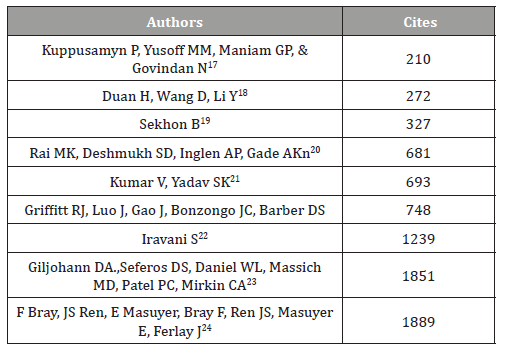
Table 3: List of most cited works on the Publication Title & Number Citeded.
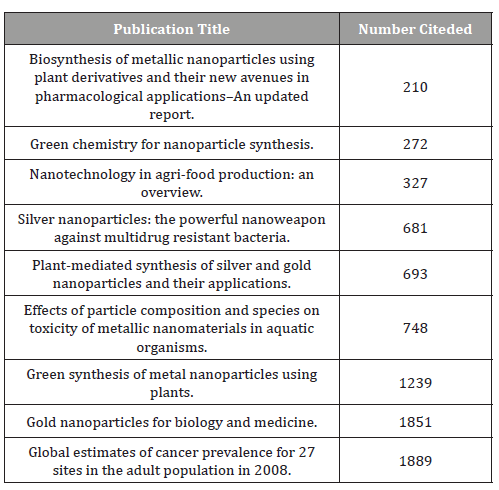
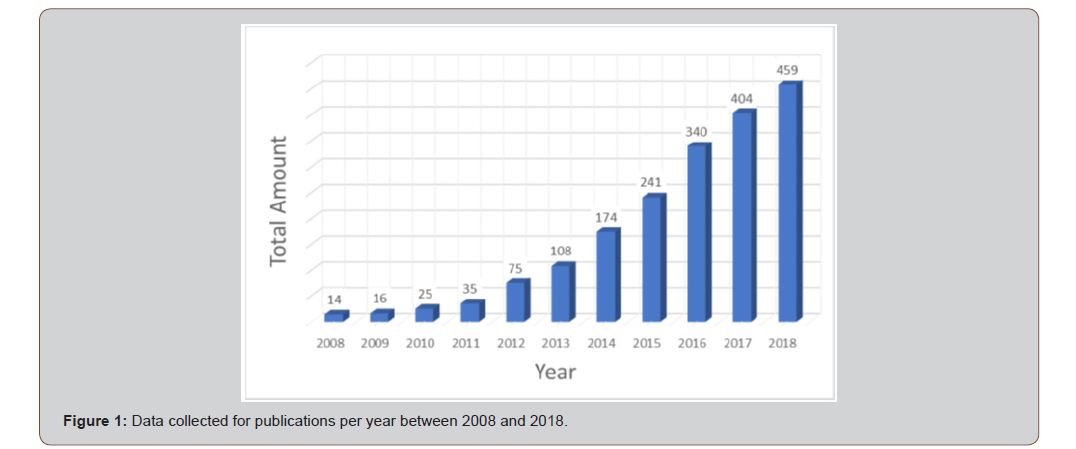

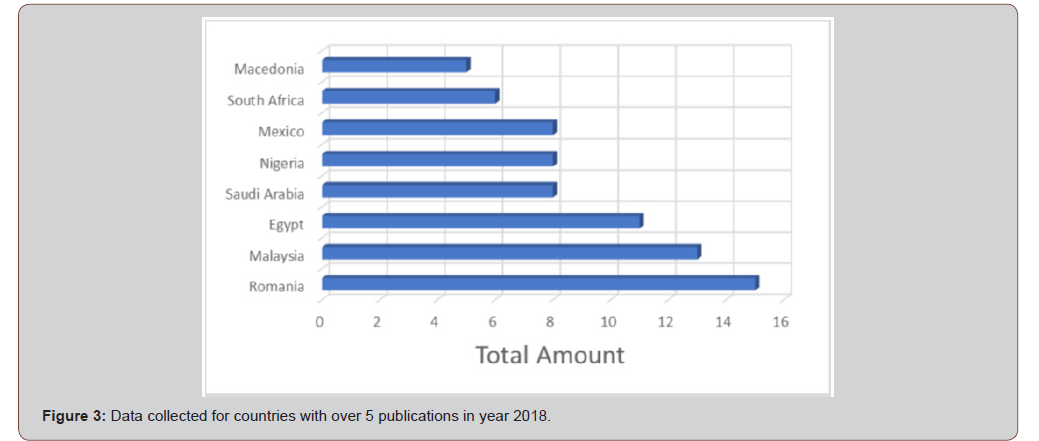
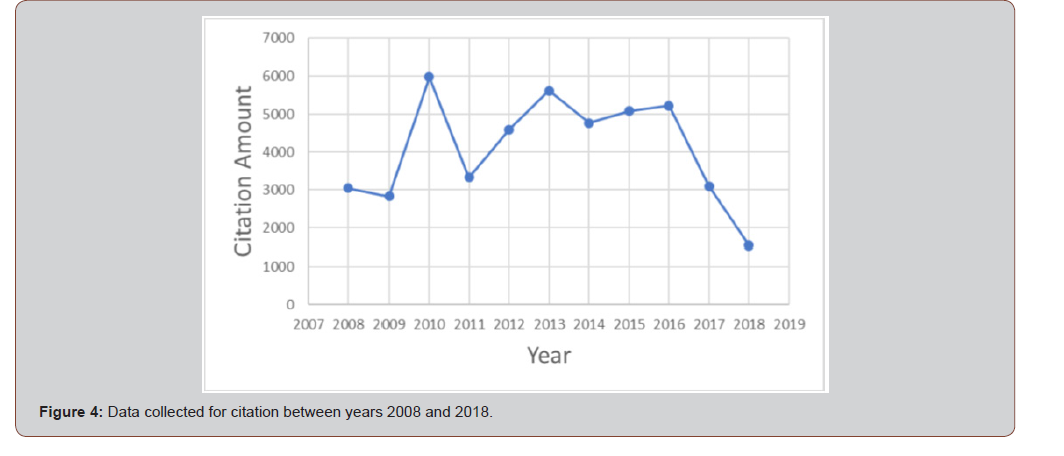


Conclusions
The Bibliometric Analysis performed in this work, allowed to conclude the importance in search relevant information about a specific subject. Through the analysis raised, it was possible to perceive a great interest of the academy in seeking greener methodologies for obtaining nanoparticles, due to the importance of nanotechnology. Through the analysis raised, it was possible to perceive a great interest of the academy in seeking greener methodologies for obtaining nanoparticles, due to the importance of nanotechnology today. In Brazil, few studies were found on the subject, with only 17 publications, a lower number when compared to the number of publications made in India, for example. Thus, the bibliometrics performed here allowed us to show the importance of carrying out works involving the synthesis of nanoparticles by greener routes, as well as a deeper research aiming to find new methodologies and technologies, in order to give more awareness about the subject, as well as due importance.
Acknowledgment
None.
Conflicts of Interest
The authors thank the National Council for Scientific and Technological Development (CNPq), Coordination for the Improvement of Higher Education Personnel (CAPES - Finance Code 001), Funder of Studies and Projects (FINEP PRESAL Ref.1889/10) and Carlos Chagas Filho Foundation for Research Support of the State of Rio de Janeiro (FAPERJ) for the financial support and scholarships.
References
- Husen A, Siddiqi KS (2014) Photosynthesis of nanoparticles: concept, controversy and application. Nanoscale Res Lettn 1: 1–24.
- Barabadi H, Ovais M, Shinwari ZK (2017) Anti-cancer green bionanomaterials: present status and future prostpecs. Chem Lett.
- Bonde S (2011) A biogenic approach for green synthesis of silver nanoparticles using extract of Foeniculum vulgare and its activity against Staphylococcus aureus and Bioscience.
- Rao K, Reddy PR, Rao KM, Kumar SP (2015) A green approach to synthesize silver nanoparticles from natural polymer for biomedical application. Indian J Adv Chem Sci.
- Seo YS, Cha SH, Cho S, Yoon HR (2015) Caffeic acid: potential applications in nanotechnology as a green reducing agent for sustainable synthesis of gold nanoparticles. Nat Prod 10(4): 627-630.
- Mahakham W, Theerakulpisut P, Maensiri S (2016) Environmentally benign synthesis of phytochemicals-capped gold nanoparticles as nanopriming agent for promoting maize seed germination. Sci Total.
- Nasrollahzadeh M, Sajadi SM (2015) Green synthesis of copper nanoparticles using Ginkgo biloba L. leaf extract and their catalytic activity for the Huisgen [3+ 2] cycloaddition of azides and alkynes at room temperature J Colloid Interface Sci 457: 141-147.
- El-Kassas HY, Aly-Eldeen MA, Gharib SM (2016) Green synthesis of iron oxide (Fe3O4) nanoparticles using two selected brown seaweeds: Characterization and application for lead bioremediation. Acta Oceanol Sin.
- Singh J, Dutta T, Kim KH, (2018) Green’synthesis of metals and their oxide nanoparticles: applications for environmental remediation. J.
- Mukherjee A, Pokhrel S, Bandyopadhyay S, Lutz Madler, Jose R Peralta-Videa (2014) A soil mediated phyto-toxicological study of iron doped zinc oxide nanoparticles (Fe@ ZnO) in green peas (Pisum sativum L) Chem Eng 258: 394-401.
- Machado S, Pinto SL, Grosso JP, Nouws HPA (2013) Green production of zero-valent iron nanoparticles using tree leaf extracts. Sci Total environment 445-446: 1-8.
- Jeyasundari J, Praba PS, Jacob YBA (2017) Green synthesis and characterization of zero valent iron nanoparticles from the leaf extract of Psidium guajava plant and their antibacterial activity. Sci Rev.
- Mandal D, Mishra S, Singh RK (2018) Green synthesized nanoparticles as potential nanosensors. Environ Chem Med.
- Mousavi SM, Hashemi SA, Ghasemi Y (2018) Green synthesis of silver nanoparticles toward bio and medical applications: review study. Artif Cells 46(sup 3): 855-872.
- PNN Daima, (2016) Rational engineering of physicochemical properties of nanomaterials for biomedical applications with nanotoxicological perspectives. Nano Converg 3(1): 1.
- Balasubramani G, Ramkumar R, Krishnaveni N (2015) GC–MS analysis of bioactive components and synthesis of gold nanoparticle using Chloroxylon swietenia DC leaf extract and its larvicidal activity. Photochem 148: 1-8.
- Torres R, Diz VE, Lagorio MG (2018) Effects of gold nanoparticles on the photophysical and photosynthetic parameters of leaves and chloroplasts. Photochem Photobiol Sci. 17: 505–516.
- Kanipandian N, Kannan S, Ramesh R (2014) Characterization, antioxidant and cytotoxicity evaluation of green synthesized silver nanoparticles using Cleistanthus collinus extract as surface modifier. Mater Res 49: 494-502.
-
Thuanny Moraes De A, Kaushik P, Fernando Gomes de S. Bibliometric Analysis of the Hot Theme “Phytosynthesized Nanoparticles”. Arch Biomed Eng & Biotechnol. 4(1): 2020. ABEB.MS.ID.000580.
-
Intracellular, Extracellular ice crystals, Cumulus cells, Denuded oocytes, Cryopreservation, Tissues, Organs, Oocyte maturation, Meiotic arrest, Meiotic resumption
-

This work is licensed under a Creative Commons Attribution-NonCommercial 4.0 International License.






